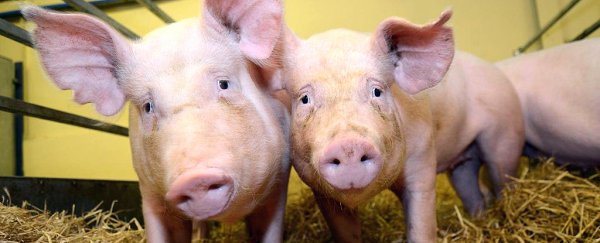There's a virus called PRRS that's every pig farmer's nightmare - it attacks young pigs and is estimated to cost farmers around US$2.3 billion a year. But now scientists may have found a gene editing method that can block the spread of this terrible disease.
A team of researchers have bred genetically engineer pigs resistant to PRRS or Porcine Reproductive and Respiratory Syndrome, and unlike previous experiments to combat the deadly virus, the animals haven't shown any other changes in their general health or behaviour.
It's the latest example of how careful DNA editing can benefit the food and agriculture industry – but the researchers admit that more tests and indeed new laws covering genetically altered foodstuffs are going to be needed before meat from these pigs can reach anyone's plate.
"First and foremost we need broader public discussion on the acceptability of gene-edited meat entering our food chain, to help inform political leaders on how these techniques should be regulated," says one of the team, Christine Tait-Burkard from the University of Edinburgh in the UK.
"We also need to carry out longer term studies to confirm that these genetic changes do not have any unforeseen adverse effects on the animals."
PRRS attacks the lungs of pigs, causing problems with breathing and ultimately death in some cases. If pregnant sows get infected, it can cause them to lose their litter, and vaccines have so far proved ineffective against the disease, since the virus is evolving rapidly.
So instead of trying to fight the virus itself, the team targeted a receptor on pig cells called CD163. A small section of the CD163 gene was removed – the section that the PRRS virus attaches to – while the rest of the receptor was left untouched.
This approach is what made the study different from earlier attempts: DNA editing has been used to remove the CD163 gene before, but this time only a part of it was tweaked. That allows the receptor to continue fulfilling its normal role in the body and minimises the chances of side effects, according to the researchers.
Our old friend CRISPR/Cas9 is responsible for the breakthrough – the ultra-accurate modern-day method of chopping out certain pieces of DNA while leaving the rest intact. It's already been used in a host of promising studies.
In this case, lab tests had previously shown encouraging results, but this is the first time the scientists also exposed grown, genetically modified pigs to the virus. Follow-up blood tests showed no sign of PRRS.
"These results are very exciting and further underscore the potential, through gene editing, to provide incredible benefits to the global pork industry, and society as a whole, by improving animal health," says Jonathan Lightner from animal genetics company Genus PLC, which worked with the research team on the project.
Genetically modified animals are banned from the food chain in Europe and are subject to very tight restrictions in the US, but there are signs that regulations are slowly being relaxed. The scientific argument is that the advanced techniques we have today aren't too different from targeted breeding.
In this case, no non-pig genes have been introduced to protect against PRRS, so the gene editing process could be seen as merely speeding up something that could have happened naturally anyway.
Those debates are a whole separate story – but for now, it looks like scientists may finally have found a way to end the scourge of one of the costliest pig diseases around.
"If these studies are successful and the public are accepting of this technology, we would then be looking to work with pig breeding companies to integrate these gene edits into commercial breeding stocks," says Tait-Burkard.
The research has been published in the Journal of Virology.
